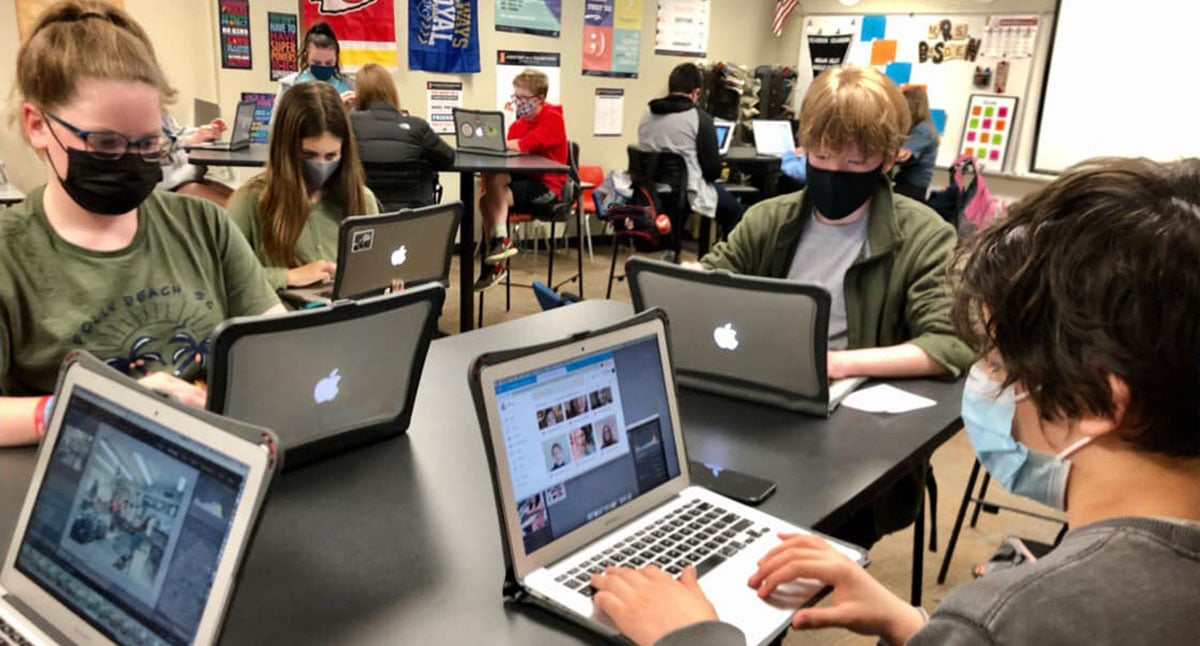
As a middle school adviser, Rachel Basden guides her staffers to “learn, live and breathe” leadership from day one. Here’s how she empowers students to become successful yearbook leaders.
Empowering my journalists to be leaders, in the span of their two years in middle school starts from week one. I have two leadership groups that work in tandem. One consists of head, copy, photography, layout & design and sunshine editors. Sunshine consists of those who can do various roles and as younger kids were often the helpers.
The other half of the group consists of student leaders. They don’t need to come to our meetings, since they have situations in their lives that make it impossible to stay committed. Some will perform more like editors, as they’re able, while others are leaders with knowledge to share with their classroom teams.
From day one, my journalists learn, live and breathe the concept that we are all a team, ALWAYS. This means in our classroom, outside our classroom and wherever we go. It also means they’re still a team, as they may shift into different team groups. Together, they learn much more and can do much more. They also learn that they represent not only our school but also our journalism program, which stands for truth and justice.
My leaders do much of the modeling of our values by leading, guiding, and sometimes kindly correcting those in their table groups. When first-year students need to work without the leaders, those leaders use their space in the back, where they have several areas to work within, while also keeping an eye on the first years. Meanwhile, the first-year students see how focused and engaged the leaders are when doing higher level journalism work, which often makes many want to become them. They also notice the respect they have for one another, as well as from their peers outside of class and our school staff.
My leaders meet regularly before and after school with one weekly meeting check-in where all are expected to come. The other times, they come in to work together to get the jobs done well, and as a team. As my leaders notice certain qualities within our first years, they share it with me and spend time giving them valuable input on what they notice, which gives those students confidence. At times, I share my insights on those in their groups with those leaders, so they can give me feedback. I also spend time having conversations one on one with my journalists, to discover if they’re invested and may have a future in journalism.

The 2021-22 journalism leadership team at Indian Hills Middle School. Photos by Rachel Basden
Once they are interested, training begins after I share with their families what it involves. Then, it starts immediately as I test them out in the class environment, to see how they manage. It continues when they come for our before/after school times to observe, shadow and then work with the current leaders. From there, the leaders and I start seeing what roles may fit best for them and which teams they should join to provide a balance.
Since my leaders can’t drive and clearly have less control of life than their high school counterparts, I found it best to have at least four or more of each editor group to have enough for each hour. I work with the school counselors to try and arrange those students’ schedules, so there’s at least one of each editor type in each section. This allows all students to experience not only what journalism is through me, but also through them. They come to value that what we do matters greatly and honestly, they tend to manage each other by using positive reinforcement and talking with them in a way that shows that there’s still some growth needed, but that as leaders, they are there to help them.
Also, in some years one or more of our first-year journalists who are in eighth grade join us already with clear leadership skills, along with already having or quickly developing great journalistic skills. Some of them become honorary editors. While nobody but our journalism classes know this, those students can attend meetings and many also join journalism in high school. In fact, in 2020, one of our honorary editors was often the glue for many others to keep on working.

2020 leaders returned last July to help the new 2021 leadership team distribute 2020 yearbooks. Photos by Rachel Basden
Once summer hits, it’s time for two-a-week for two hours a session workshops in my classroom. After the last week of school when our classes vote on the best THEME-POSAL concepts, I work with the new leaders to get the yearbook started and help them form bonds as the new leaders for the upcoming year. Often, former editors will come and join, as a way of helping the newbies and as a way of giving back to a program that gave so much to them. This also allows even more connectivity between our school and our high school journalism program. As I often add to our social media posts, #ittakesajournalismteam.
After 19 years of advising and teaching middle and high school journalists both in New Jersey and in Kansas, Rachel Basden launched the journalism course into the Shawnee Mission School District’s middle schools. This year was her fourth year teaching journalism for Indian Hills Middle School, after two years of advising a club. You can follow Rachel and her yearbook staff on Instagram @ihms_journalism and on Twitter @ihmsjournalism.

